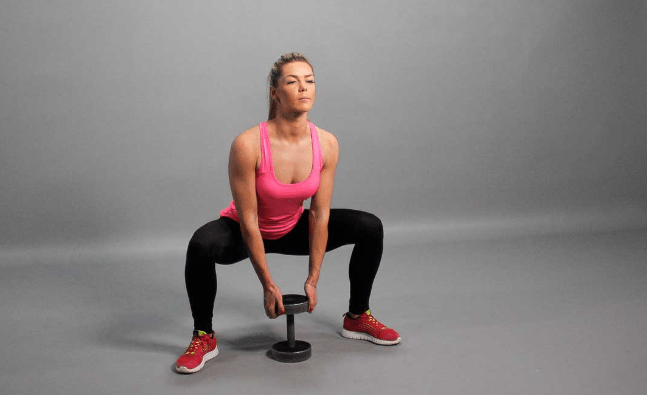The sumo dumbbell squat is a dynamic exercise that takes the classic squat to a whole new level. Not only does it target your quads, glutes, and hamstrings, but it also places a strong emphasis on your inner thighs, those often-neglected muscles. This guide will delve into the benefits of the sumo dumbbell squat, proper form, and variations to suit your fitness level.
Why Sumo? Why Dumbbells?
The sumo stance, with your feet wider than shoulder-width apart and toes pointed outwards, opens up your hips and allows for a deeper squat. This deeper squat translates to greater activation of your glutes and inner thighs, helping you build strength and sculpt those beautiful curves.
Dumbbells, on the other hand, offer a unilateral (one-sided) challenge. This means each leg works independently, promoting better balance and stability. Compared to a barbell squat, dumbbells allow for a more natural range of motion, reducing stress on your lower back.
Mastering the Sumo Dumbbell Squat:
Here’s a step-by-step guide to performing the sumo dumbbell squat with perfect form:
- Grab Your Weights: Choose dumbbells that are challenging but comfortable. You shouldn’t compromise form for heavier weights.
- Stance is Key: Stand with your feet wider than shoulder-width apart, toes pointed outwards at a 45-degree angle. Maintain a straight back by engaging your core muscles.
- Lower Yourself: Hold the dumbbells by your sides with palms facing inwards. Squat down while bending your knees and pushing your hips back. Imagine sitting into an invisible chair.
- Form Matters: Keep your knees tracking in line with your toes, don’t let them cave inwards. Your back should remain straight, chest lifted throughout the movement.
- The Deep Squat: Squat down until your thighs are parallel to the ground (or as low as comfortably possible). Squeeze down your glutes at the bottom of the squat.
- Push Up: Drive through your heels to go back to the starting point. Keep your core active during the activity.
Reps, Sets, and Rest:
Beginners can begin with 2-3 sets of 8–12 repetitions. As you gain strength, you can increase the weight, reps, and sets. Remember to take 30-60 seconds rest between sets to allow your muscles to recover.
Modification Magic:
The sumo dumbbell squat can be modified to suit your fitness level:
- Bodyweight Squat: Ditch the dumbbells and perform the squat with just your bodyweight for a beginner-friendly option.
- Box Squat: Use a sturdy box or bench to set your squat depth. This is a great way to ensure proper form, especially for those new to the exercise.
- Goblet Squat: Hold a single dumbbell close to your chest for a more core-engaging variation.
Unlocking Your Inner Strength:
The sumo dumbbell squat is a versatile exercise that can be incorporated into your lower body workout routine. From building stronger, sculpted legs to improving your balance and hip mobility, this exercise offers a powerful package. So, grab your dumbbells, embrace the sumo stance, and get ready to conquer your lower body goals!
